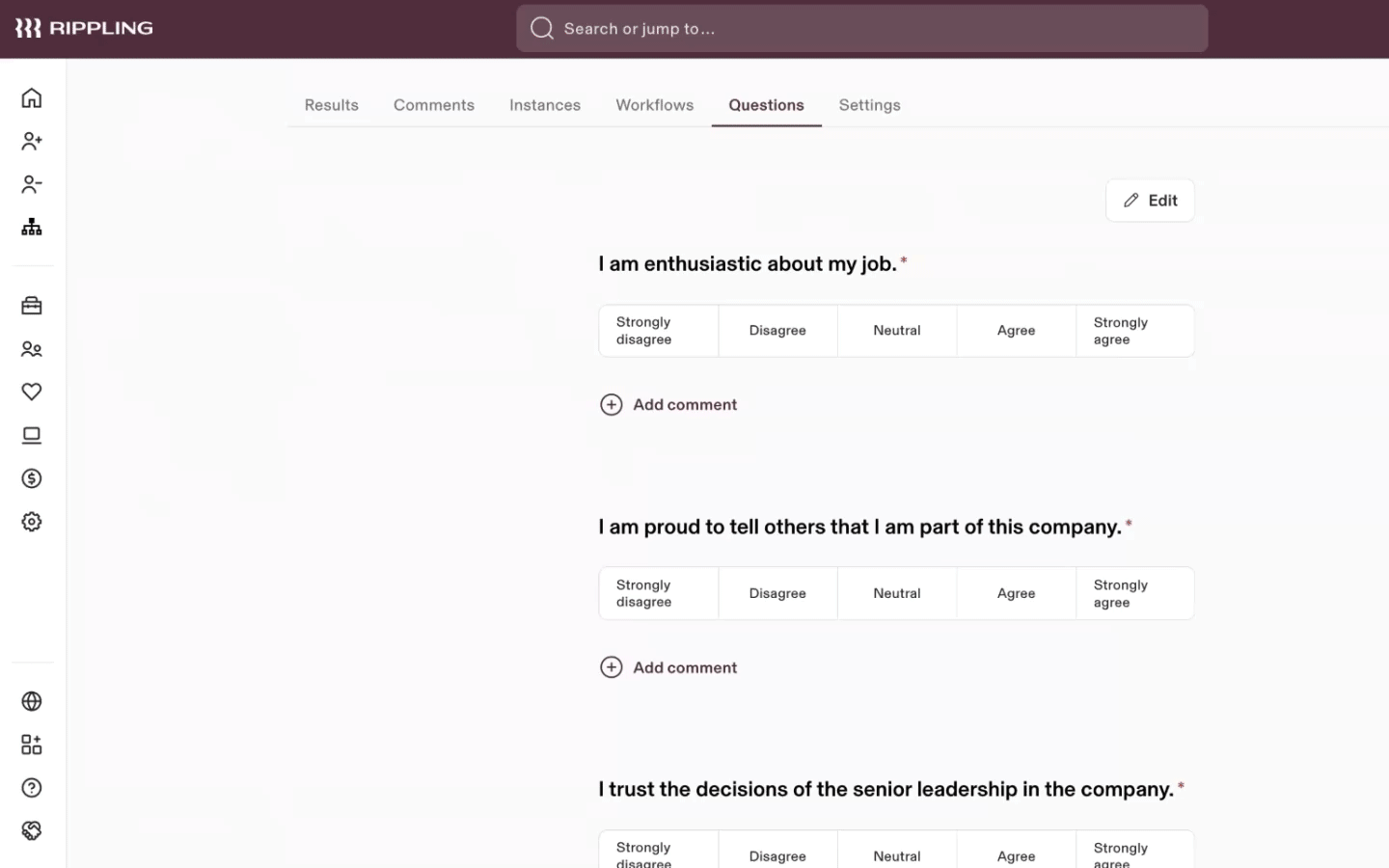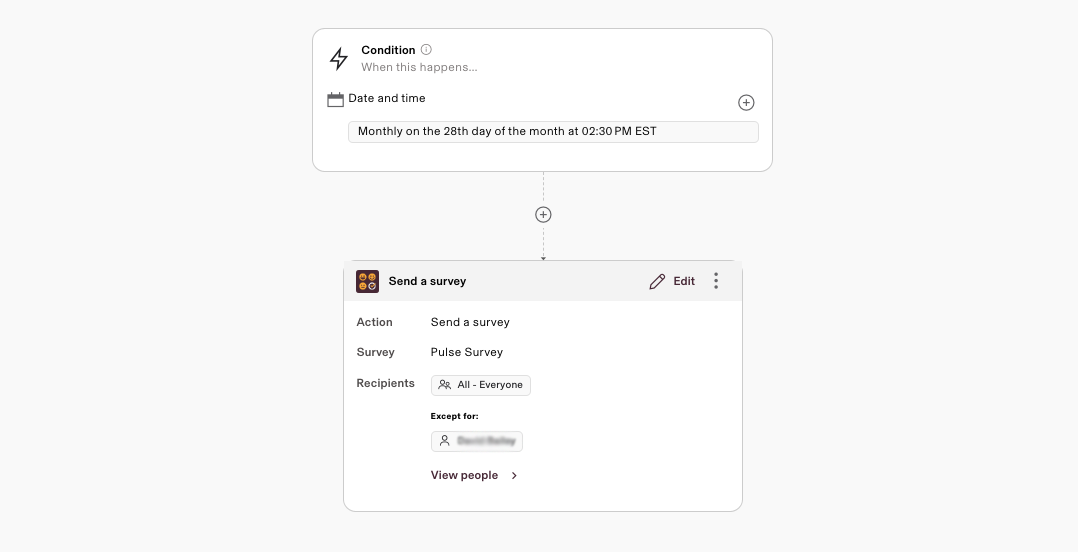How we increased employee engagement with Rippling pulse surveys

Alex Batson is an HR generalist at BTC Inc. Alex is a Rippling power admin user who uses the product multiple capacities to tackle complex business problems spanning from recruiting to payroll and benefits.
At BTC Inc., our mission is to promote Hyperbitcoinization. We do this in a variety of ways like global conferences, a quarterly print magazine, and in-person community-building initiatives. In order to stay ahead in an ever-evolving and fast paced industry, we need to ensure our team remains actively engaged and aligned with our mission. It’s important to engage with our employees during times of change and hypergrowth. That’s where Rippling pulse surveys came in.
Here’s how we increased survey participation rates to nearly 100% by revamping our approach to feedback with Rippling.
The problem: scattered systems hindered participation
Before implementing Rippling, we used Lattice for surveys. While effective for gathering employee feedback, it wasn’t integrated into our people management platform. This disjointed setup created extra work for employees, resulting in lower participation rates. We’ve learned that when tools are scattered across platforms, employee engagement drops significantly.
We needed a solution that streamlined surveys into a single, cohesive system—one that was easy for employees to use and for our team to analyze.
The solution: pulse surveys integrated with Rippling
When we transitioned to Rippling as our people management platform in January, pulse surveys became a top priority. Having surveys embedded within Rippling simplified the process for employees, and participation rates soared to nearly 100% each month.
Here’s how we set up and used Rippling pulse surveys:
Step 1: craft meaningful questions
We designed our pulse surveys to cover essential areas of employee experience and engagement. Our updated survey includes six statements that employees can respond to with "agree," "disagree," or "neutral." Employees can also leave comments. The six questions are:
- I’m enthusiastic about my job.
- This opening question encourages employees to reflect on their roles and sets an engaging tone for the rest of the survey.
- I’m proud to tell others I’m part of this company.
- This question is crucial, especially in an industry as volatile as ours, where employee pride directly impacts morale and retention.
- I trust the decisions of the senior leadership in the company.
- Leadership trust is vital in a fast-moving startup environment where decisions are often made quickly.
- I have a clear understanding of our company’s mission, vision, and values.
- Strong responses here reassure us that employees are aligned with our core principles.
- This company is headed in the right direction.
- This summary question ties everything together, providing valuable insights into overall sentiment.
- I would recommend working at the company to a friend.
- This personal question gauges how employees feel about recommending BTC Inc. as a workplace.

Step 2: automate distribution
Our pulse survey is triggered through a workflow and sent to employees on the 28th of each month. Employees have seven days to respond, and a report is automatically generated for analysis on the fifth of the following month. This automation ensures timely responses and makes reporting easier for my team.

Step 3: analyze and act on feedback
Rippling’s reporting features make it easy to view responses and trends directly within the platform. We can also export data to create custom dashboards and reports. Equipped with employee comments and insights, I helped the C-suite understand employee questions surrounding change and the direction of our company which were addressed in the right way.
The impact: higher engagement and actionable insights
Integrating surveys into Rippling has transformed how we engage with employees and act on their feedback. Here are some of the most significant benefits:
Near-perfect participation
Moving surveys into Rippling boosted participation rates to nearly 100% each month. Employees now find it easier to complete surveys, and our streamlined approach reduces friction.
Actionable feedback
Employee comments have been invaluable, especially on questions about leadership and company direction. For example, when employees expressed concerns about sudden changes or unclear communication, we shared that feedback with leadership, which led to better transparency in decision-making.
Real-time reporting
Rippling sends out survey results automatically on a monthly basis. We love being able to look at the reports and insights in Rippling, but it’s also great to have the flexibility to manipulate the data into charts, bars, and graphs outside of Rippling. This allows us to tailor reports for various stakeholders, from team leads to C-level executives, which has been crucial for aligning company-wide strategies with employee sentiment.
Why Rippling stands out
What sets Rippling apart is its ability to integrate seamlessly into every stage of the employee lifecycle. Pulse surveys aren’t just another feature—they’re a tool for building trust and transparency. The flexibility to automate workflows, customize questions, and analyze data has made Rippling an indispensable part of our HR toolkit.If you’re looking for a way to simplify surveys and gain actionable insights, Rippling’s pulse surveys could be the solution. At BTC Inc, they’ve helped us strengthen trust, align our team, and make data-driven decisions.
This blog is based on information available to Rippling as of February 3, 2025.
Disclaimer: Rippling and its affiliates do not provide tax, accounting, or legal advice. This material has been prepared for informational purposes only, and is not intended to provide or be relied on for tax, accounting, or legal advice. You should consult your own tax, accounting, and legal advisors before engaging in any related activities or transactions.









